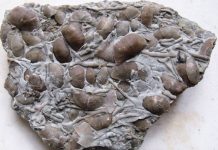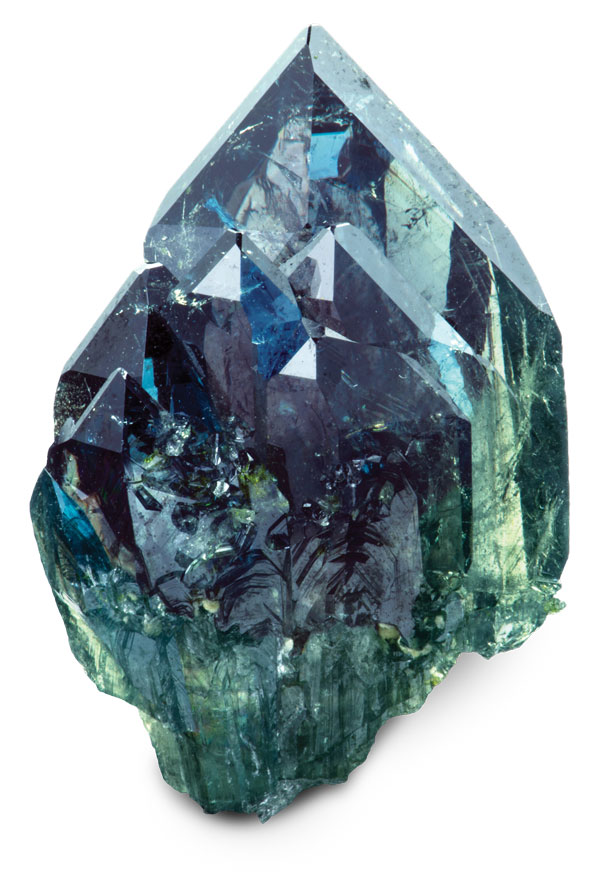
What is mined in Tsumeb, Namibia? The mine now known as the Ongopolo mine is world-famous for its amazing assortment of common and rare mineral species, some of them the world’s finest. Among the nearly 350 different known species from this location are unknown species first found in the ores of Tsumeb, where the study continues.
The deposit produced a variety of metals, including copper, lead, zinc, silver, gold, cobalt, and germanium, from a huge mineralized nearly vertical pipe that had surfaced and was heavily oxidized to depth. Mining reached nearly a depth of over 4,000 feet before closing.
Three Oxidation Zones
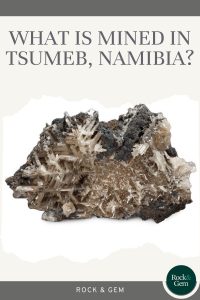
Many general mineral collections and mineral museums have fine examples of minerals from this African source. This is because Tsumeb is an exceptional ore deposit. It had not one upper oxide zone but three zones of oxidation separated by primary sulfide ore bodies. In addition, each oxide zone has a somewhat different suite of minerals with its own variety and dominant species that developed there.
Most ore bodies exposed to the elements have an upper oxide zone where the primary sulfide ores have been broken down and changed by atmospheric components. Below a deposit’s oxide zone is the primary ores untouched by weathering. At Tsumeb, in some areas, both primary and secondary minerals occur together.
At Tsumeb, the upper oxide zone extends much deeper than normal. After mining the oxide zone, miners expected and did encounter sulfide ores but continued mining at depth, opening a second oxide zone that extended down several mine levels before the ores were, once again, primary sulfides. A third oxide zone contained another treasure trove of secondary collectible specimens like scorodite and wulfenite.
Ore Body Fracture
How did three oxide zones happen in a single ore body at great depth? The answer is that not only was the ore body fractured by normal faulting, but a major fault, the Great Fault, developed some distance away and extended diagonally deeper and deeper from a distant surface, cutting across the Tsumeb ore body at a great depth. This created a rare avenue, which introduced oxidizing conditions where the ore body was exposed to the earth’s surface.
Connected to this Great Fault were the North Break Zone and South Break Zone. Together these faults created a second and then the third suite of oxidized secondary minerals. All this makes the Tsumeb ore body very complex structurally and a unique hydrothermally produced ore body.
Unique Species
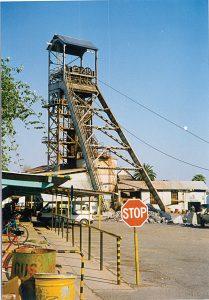
BOB JONES
In addition, the hydrothermal solutions that created the deposits were also very complex, bringing in many trace elements which helped create a wide range of species. Currently, specimens from Tsumeb are still being studied, despite a 1990s closure. Thus far, the deposit has produced about 350 different species, many of them from the three oxide zones.
With three oxide zones discovered over a long period of time, Tsumeb was a prolonged source of choice secondary minerals, starting in about 1906 and continuing into the 1990s. As each oxide zone was breached at depth, various species were produced in quantity – some species were common across the board, others were unique.
Zones By Mineral
The upper oxide zone at Tsumeb is noted for exceptional azurite and malachite, including the ‘Bird’s Nest’ azurite to be described later. The middle zone is known for its cerussite production and dioptase discoveries. The lowest oxide zone is better known for quantities of smithsonite. Much more rare are the scorodite crystals found in the lowest oxide zone. Only a few specimens were found, and it is one of the very uncommon species found here.
The Tsumeb ore body is an oval-shaped vertical pipe structure that forced its way into a series of crustal dolomitic and carbonate limestone formations. This host rock dates over 500 million years. The ore body did not appear at that time. It invaded the host rocks less than 300 million years ago. The entire area was later uplifted and subjected to repeated fracturing, faulting and dissolution, so the formations of this region are termed karst formations. Groundwaters and movements have created caves and underground channels by dissolving some of the dolomite and limestone formations. These are subject to surface collapse when large enough, and the resulting pits fill with water to form a lake. There is such a large lake at Tsumeb.
Tsumeb Exploration
The Tsumeb copper-lead deposit was known and surface mined by natives before Europeans explored Africa. The local tribes were drawn to the area, which was a green stained low hill of rocks. They collected surface minerals and used them for trade to other tribes like the Ovambo peoples, who knew crude smelting methods to recover copper. As for the name “Tsumeb,” there is some question about its origin. It may mean “place of algae,” probably referring to the greenish waters or “place of frogs,” many of whom lived there.
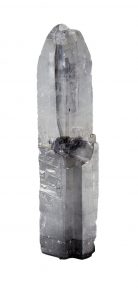
HERITAGE AUCTIONS
When Europeans did begin to explore Africa, the English and others learned of Tsumeb’s “green hill,” and in the mid-1800s, bought the area from the local tribes in hopes of mining it. They were not successful, so when Germany declared the entire Namibia area a German Protectorate, they took over development. The Protectorate was later named South West Africa, and mining began in about 1906.
During World War I, Germany’s Frederick Kagel was the mine superintendent, and he was also a collector. They mined the upper oxide zone and produced some amazing azurite specimens, most of which ended up in Germany.
One German collector, Carl Bosch. a noted industrialist inventor, had a huge collection rich in Tsumeb species. After World War II, the Carl Bosch collection was brought to America and placed at Yale in hopes the family could sell it. Curator Paul Desautes of the Smithsonian found out about the collection and bought it. It took two huge moving vans to transport it to D.C. Frederich Kagel’s Tsumeb pieces are in the Los Angeles County Museum as part of the collection of Dr. Mark and Jean Bandy.
Bird’s Nest Azurite
The upper oxide zone azurite that many judge as the most beautiful Tsumeb azurite in the world can be seen in the New York Natural History Museum. It is the “Bird’s Nest” azurite. The specimen is about 6.5 inches, a more or less oval flat minimum matrix which is crowned by an inter-grown stack of tightly clustered azurite crystals measuring up to five inches set at a jaunty angle leaning against smaller sharp blue crystals of azurite that support the large crystals. There is no damage and the larger crystals have subtle parallel striations on each crystal face.
The Bird’s Nest was mined in the 1940s in the upper oxide zone by a miner who was off shift. He kept it for a time, but eventually, his bar bill in the miner’s hotel got so large that he had to use the azurite to pay the bill. There it was displayed for some time, but eventually, the Newmont Mining company took possession of the piece and put it on display in the lobby of their New York office along with a major gold specimen.
Secondary Minerals
Later, Tsumeb’s three oxide zones produced huge quantities of secondary minerals, many of them rare, or unusual. They were well below the near-surface oxide ore zone by hundreds of feet. Once they mined through the second oxide zone they eventually got back into sulfides. This was too deep to have been attacked by surface waters from above, and mining continued through the second oxide zone into sulfide ores again. Remarkably, a third oxide zone was breached. Clearly, they were mining something unique and very complex. What makes these lower oxide zones more interesting is the primary metals including rare elements like germanium, gallium, and rare earths.
With three oxide zones producing colorful, sometimes rare, and well crystallized secondary mineral species, Tsumeb became exceedingly popular among dealers. Note, the oxide and primary sulfide zones were interwoven because of repeated faulting as the Great Fault system and the oxide zones extended into the sulfides at differing levels.
The upper oxide zone is well known for superb azurites along with different types of malachite. Pseudomorphs, after azurite crystallized malachite on calcite, native copper and cuprite were found. Tsumeb is a copper-lead deposit, so secondary copper and lead minerals were found throughout the ore body but concentrated in the oxide zones.
Cerussite
The second oxide zone is noted for the great amount of cerussite and dioptase it produced. Huge quantities of cerussite were twinned and ranged in size from under an inch to seven inches long.
The most beautiful and rarest form of cerussite to get is the so-called snowflake twins. Though cerussite is a common mineral, snowflake twins from Tsumeb were rare indeed. Real snowflakes have a distinctive flat radiating star-like form with six radiating crystals forming a pattern. Cerussite twins form the same shape. Such twins can be smaller than an inch, but Tsumeb’s rarest snowflakes are thick clusters of twinned crystals. A snow-white can be nearly ten inches across!
Other twin forms of Tsumeb cerussite are elongate “v” twins where two crystals are attached at the base that diverge to form the “v.” These can be anywhere from under an inch to seven inches long, which is a rarity.
Dioptase
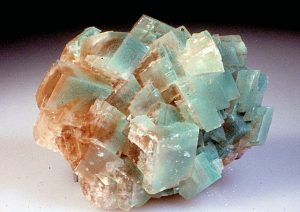
PRIVATE COLLECTION
The other mineral most common in the second oxide zone is dioptase, the green copper silicate hydroxide. The color of this mineral, due to free copper ions, ranges from very dark green to light green.
The crystal form of dioptase is rhombohedral and is often seen as single, doubly terminated crystals with a high luster. It also forms tight inter-grown clusters, or as individual crystals, scattered on a contrasting calcite matrix. Dioptase can crystallize with other species like wulfenite and cerussite, but its most common matrix is white crystallized calcite, contrasting nicely with the dioptase. As for size, dioptase crystals are often microscopic elsewhere but are exceptional here. They can range up to an inch long, most often clustered in tightly grouped crystals along with singles on the same specimen.
Other Specimens
The main metal ores in the deposit were copper and lead along with zinc, silver, and germanium, an element responsible for some rare and new species. Specimens of copper and lead were found throughout the deposit. Native copper was not abundant and often occurred locked in calcite.
Cuprite
Cuprite was common in the upper oxide zone and often acted to add color to other species. A great variety of other copper metals were found including primary tetrahedrite, tennantite, and chalcocite in well-crystallized groups. In the oxide zones, fine red cuprite crystals were often encountered, never large, but in nice cubic crystal clusters of good red color. Cuprite’s good red color was often the cause of color in other minerals, most often calcite.
Calcite
The Tsumeb deposit was in a dolomitic-limestone environment so calcite and aragonite occur throughout the deposit. Calcite tended to form in rhombic crystals which suggests the operating temperature here was not too high, something in the 100 to 300°C range.
Of particular interest to collectors are the rhombic, slightly rounded, calcite crystals in stepped clusters with included dioptase. Its green color can be diffused or zoned throughout the calcite. The quantity of calcite from here was enormous. Aragonite was not as abundant but was found in nice diverging crystals. Larger quantities as massive layers were more common.
Mimetite
Quantities of mimetite in a variety of forms were also mined. Crystals were found in the elongate acicular form several inches long to fine clusters in various shades of canary yellow.
Leadhillite
Among the several species found here, that are world-beaters, are leadhillite. The mineral is considered quite rare worldwide, but Tsumeb produced the best by far. Some leadhillite crystal groups are diverging prismatic crystals nearly two inches long. They are very showy, usually white, but can be colored by inclusions. The largest leadhillite crystals I’ve seen from Tsumeb are three-sided flat crystals, glass clear, measured two inches on an edge. Smaller clusters of triangular leadhillite from white gray were also mined.
Adamite
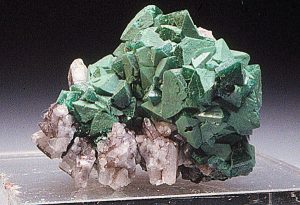
JONES COLLECTION
Adamite, mainly cuproadamite, has been found here along with olivenite. Both have been found in fine crystal groups well worth collecting. These two minerals are dimorphs and only differ in chemistry, so they can exchange their metal cations copper and zinc. This has created a puzzle since they are so close chemically.
Now scientists have decided when these two species exchange copper and zinc we think the specimen is cuproroadamite. But now scientists have decided a new mineral has emerged and has been identified at Tsumeb. The balance between adamite and olivenite is so close that the new rare mineral is named zincoolivenite. Can you tell the difference between this new mineral and cuproadamite? Not without special equipment. So, if you own a Tsumeb cuproadamite you may as well have the new mineral zincoolivenite.
Oddly, iron minerals were not as common as Tsumeb. A few qualify as rare including lusklockite, a brown hair-like mineral, found initially on the dump; and scoriite, a lovely blue mineral, from the third oxide zone in small amounts.
Zinc Pockets
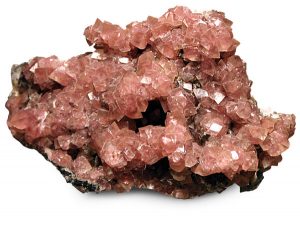
COLLECTOR’S EDGE SPECIMEN
When miners encountered areas particularly rich in a species, they would often refer to the area as a “pocket.” The zinc “pocket“ produced an amazing assortment of mimetite. In the same area, they also found another zinc mineral, wulfenite. These ranged from thick tabular crystals to near windowpane form. The tabular crystals were highly modified and thick, and often of a dark brown, orange color. The more delicate wulfenite blades were usually yellow on matrix and quite attractive.
The zinc mineral that was most abundant in Tsumeb is smithsonite. It was encountered primarily in the third oxide zone. Most smithsonite from here is typically botryoidal in large curving mounds with good luster. The colors of smithsonite can range almost across the spectrum from white to blue, green, pink, or colorless. Crystals tend to be rhombic and slightly rounded in tight clusters that are hand-sized. A greater number of smithsonite specimens were found in the later days of the deposit.
Tsumeb Today
Much to the disappointment of collectors, Tsumeb finally reached such a depth, the 36-44 level, several thousand feet down. Mining got too costly and ceased in 1996.
Currently, the smelter is operating, but not much seems to be surfacing. The dumps have been picked clean or processed.
The halcyon days of Tsumeb production are over, but not before flooding the collector market with wonderful secondary and primary minerals. Most of what you see will be azurite, cerussite, dioptase and smithsonite. In each case, large quantities of each of these species were found in more than one oxide zone. Cerussite is probably the most often mineral seen today. Smithsonite is less often available and well worth having.
We are still learning of uncommon species being found among the common ones. Tsumeb will long be remembered and appreciated for producing so many tons of really fine specimens.
This story about Tsumeb previously appeared in Rock & Gem magazine. Click here to subscribe! Story by Bob Jones.


